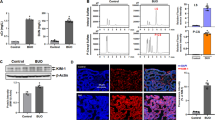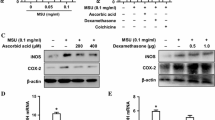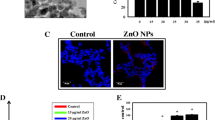Abstract
Fenton reaction is a new mechanism able to generate advanced oxidation protein products (AOPPs) by exposing the human serum albumin to the Fenton system. Here, we characterized the effects of Fenton reaction-generated advanced oxidation protein products (AOPP-FR) on the gene transcription of the nuclear factor-κB (NF-κB), cyclooxygenase-2 (COX-2), and interleukin-6 (IL-6) in human embryonic kidney cells (HEK 293). To investigate the effects of AOPP-FR and AOPP-HOCl on transcription of inflammatory genes, the NF-κB, COX-2, and IL-6 luciferase promoter activities were analyzed. AOPP-FR and AOPP-HOCl were able to induce the activation of the gene transcription of NF-κB, COX-2, and IL-6 in HEK 293 cells. However, the effects of AOPP-FR were significantly higher than the effects of AOPP-HOCl in relation to COX-2 and IL-6. AOPP-FR induces the activation of the gene transcription of NF-κB, COX-2, and IL-6 and may represent a novel pathogenic mediator of inflammation in kidney.



Similar content being viewed by others
Abbreviations
- AOPPs:
-
Advanced oxidation protein products
- AOPP-FR:
-
Fenton reaction-generated advanced oxidation protein products
- AOPP-HOCl:
-
Hypochlorous acid-generated advanced oxidation protein products
- COX-2:
-
Cyclooxygenase-2
- HEK 293:
-
Human embryonic kidney cells
- HO• :
-
Hydroxyl radical
- HOC:
-
Hypochlorous acid
- HSA:
-
Human serum albumin
- IL-6:
-
Interleukin-6
- MPO:
-
Myeloperoxidase
- NADPH:
-
Nicotinamide adenine dinucleotide phosphate
- NF-κB:
-
Nuclear factor-κB
- ROS:
-
Reactive oxygen species
References
Valko, M., D. Leibfritz, J. Moncol, M.T. Cronin, M. Mazur, and J. Telser. 2007. Free radicals and antioxidants in normal physiological functions and human disease. The International Journal of Biochemistry & Cell Biology 39: 44–84.
Himmelfarb, J., and E. McMonagle. 2001. Albumin is the major plasma protein target of oxidant stress in uremia. Kidney International 60: 358–63.
Galli, F. 2007. Protein damage and inflammation in uraemia and dialysis patients. Nephrology, Dialysis, Transplantation 5: 20–36.
Capeillère-Blandin, C., V. Gausson, B. Descamps-Latscha, and V. Witko-Sarsat. 2004. Biochemical and spectrophotometric significance of advanced oxidized protein products. Biochimica et Biophysica Acta 1689: 91–102.
Bochi, G.V., V.D. Torbitz, L.P. Cargnin, J.A. de Carvalho, P. Gomes, and R.N. Moresco. 2014. An alternative pathway through the fenton reaction for the formation of advanced oxidation protein products, a new class of inflammatory mediators. Inflammation 37: 512–21.
Gorudko, I.V., D.V. Grigorieva, E.V. Shamova, E.V. Mikhalchik, S.N. Cherenkevich, J. Arnhold, and O.M. Panasenko. 2014. Hypohalous acid-modified human serum albumin induces neutrophil NADPH oxidase activation, degranulation, and shape change. Free Radical Biology & Medicine 68: 326–34.
Rong, G., X. Tang, T. Guo, N. Duan, Y. Wang, L. Yang, J. Zhang, and X. Liang. 2015. Advanced oxidation protein products induce apoptosis in podocytes through induction of endoplasmic reticulum stress. Journal of Physiology and Biochemistry 71: 455–70.
Witko-Sarsat, V., M. Friedlander, T. Nguyen Khoa, C. Capeillère-Blandin, A.T. Nguyen, S. Canteloup, J.M. Dayer, P. Jungers, T. Drüeke, and B. Descamps-Latscha. 1998. Advanced oxidation protein products as novel mediators of inflammation and monocyte activation in chronic renal failure. Journal of Immunology 161: 2524–32.
Iwao, Y., K. Nakajou, R. Nagai, K. Kitamura, M. Anraku, T. Maruyama, and M. Otagiri. 2008. CD36 is one of important receptors promoting renal tubular injury by advanced oxidation protein products. American Journal of Physiology. Renal Physiology 295: 1871–80.
Zhou, L.L., W. Cao, C. Xie, J. Tian, Z. Zhou, Q. Zhou, P. Zhu, A. Li, Y. Liu, T. Miyata, F.F. Hou, and J. Nie. 2012. The receptor of advanced glycation end products plays a central role in advanced oxidation protein products-induced podocyte apoptosis. Kidney International 82: 759–70.
Li, H.Y., F.F. Hou, X. Zhang, P.Y. Chen, S.X. Liu, J.X. Feng, Z.Q. Liu, Y.X. Shan, G.B. Wang, Z.M. Zhou, J.W. Tian, and D. Xie. 2007. Advanced oxidation protein products accelerate renal fibrosis in a remnant kidney model. Journal of the American Society of Nephrology 18: 528–38.
Shi, X.Y., F.F. Hou, H.X. Niu, G.B. Wang, D. Xie, Z.J. Guo, Z.M. Zhou, F. Yang, J.W. Tian, and X. Zhang. 2008. Advanced oxidation protein products promote inflammation in diabetic kidney through activation of renal nicotinamide adenine dinucleotide phosphate oxidase. Endocrinology 149: 1829–39.
Holmes, R.S., and C.J. Masters. 1970. Epigenetic interconversions of the multiple forms of mouse liver catalase. FEBS Letters 11: 45–8.
Morris, J.C. 1996. The acid ionization constant of HOCl from 5 to 35°. The Journal of Physical Chemistry 70: 3798–805.
Duran, J., M. Obach, A. Navarro-Sabate, A. Manzano, M. Gómez, J.L. Rosa, F. Ventura, J.C. Perales, and R. Bartrons. 2009. Pfkfb3 is transcriptionally upregulated in diabetic mouse liver through proliferative signals. The FEBS Journal 276: 4555–68.
Capeillère-Blandin, C., V. Gausson, A.T. Nguyen, B. Descamps-Latscha, T. Druek, and V. Witko-Sarsat. 2006. Respective role of uraemic toxins and myeloperoxidase in the uraemic state. Nephrology, Dialysis, Transplantation 21: 1555–63.
Kumbasar, A., M. Gursu, C. Kaya, S. Ozturk, A. Ergen, A. Kemik, Z. Aydin, S. Uzun, S. Karadag, and R. Kazancioglu. 2012. The effect of different doses and types of intravenous iron on oxidative stress and inflammation in hemodialysis patients. Journal of Nephrology 25: 825–32.
Anraku, M., K. Kitamura, R. Shintomo, K. Takeuchi, H. Ikeda, J. Nagano, T. Ko, K. Mera, K. Tomita, and M. Otagiri. 2008. Effect of intravenous iron administration frequency on AOPP and inflammatory biomarkers in chronic hemodialysis patients: a pilot study. Clinical Biochemistry 41: 1168–74.
Prousek, J. 2007. Fenton chemistry in biology and medicine. Pure and Applied Chemistry 79: 2325–38.
Repetto, M.G., N.F. Ferrarotti, and A. Boveris. 2010. The involvement of transition metal ions on iron-dependent lipid peroxidation. Archives of Toxicology 84: 255–62.
Gonzalez, F.B., S. Llesuy, and A. Boveris. 1993. Hydroperoxide-initiated chemiluminescence: an assay for oxidative stress in biopsies of heart, liver, and muscle. Free Radical Biology & Medicine 10: 93–100.
Chance, B., H. Sies, and A. Boveris. 1979. Hydroperoxide metabolism in mammalian organs. Physiological Reviews 59: 527–605.
Pahl, H.L. 1990. Activators and target genes of Rel/NF-kappaB transcription factors. Oncogene 18: 6853–66.
Gilmore, T.D., and F.S. Wolenski. 2012. NF-κB: where did it come from and why? Immunological Reviews 246: 14–35.
Zheng, S., Z.M. Zhong, and S. Qin. 2013. Advanced oxidation protein products induce inflammatory response in fibroblast-like synoviocytes through NADPH oxidase -dependent activation of NF-κB. Cellular Physiology and Biochemistry 32: 972–85.
Guo, Z.J., H.X. Niu, F.F. Hou, L. Zhang, N. Fu, R. Nagai, X. Lu, B.H. Chen, Y.X. Shan, J.W. Tian, R.H. Nagaraj, D. Xie, and X. Zhang. 2008. Advanced oxidation protein products activate vascular endothelial cells via a RAGE-mediated signaling pathway. Antioxidants & Redox Signaling 10: 1699–712.
Cao, W., J. Xu, Z.M. Zhou, G.B. Wang, F.F. Hou, and J. Nie. 2013. Advanced oxidation protein products activate intrarenal renin-angiotensin system via a CD36-mediated, redox-dependent pathway. Antioxidants & Redox Signaling 18: 19–35.
Zhong, Z.M., L. Bai, and J.T. Chen. 2009. Advanced oxidation protein products inhibit proliferation and differentiation of rat osteoblast-like cells via NF-kappaB pathway. Cellular Physiology and Biochemistry 24: 105–14.
Cai, D., M. Yuan, D.F. Frantz, P.A. Melendez, L. Hansen, J. Lee, and S.E. Shoelson. 2005. Local and systemic insulin resistance resulting from hepatic activation of IKK-beta and NF-kappaB. Nature Medicine 11: 183–90.
Arkan, M.C., A.L. Hevener, F.R. Greten, S. Maeda, Z.W. Li, J.M. Long, A. Wynshaw-Boris, G. Poli, J. Olefsky, and M. Karin. 2005. IKK-beta links inflammation to obesity-induced insulin resistance. Nature Medicine 11: 191–8.
Marsche, G., S. Frank, A. Hrzenjak, M. Holzer, S. Dirnberger, C. Wadsack, H. Scharnagl, T. Stojakovic, A. Heinemann, and K. Oettl. 2009. Plasma-advanced oxidation protein products are potent high-density lipoprotein receptor antagonists in vivo. Circulation Research 104: 750–7.
Wang, J.C., Y. Zhao, S.J. Chen, J. Long, Q.Q. Jia, J.D. Zhai, Q. Zhang, Y. Chen, and H.B. Long. 2013. AOPPs induce MCP-1 expression by increasing ROS-mediated activation of the NF-κB pathway in rat mesangial cells: inhibition by sesquiterpene lactones. Cellular Physiology and Biochemistry 32: 1867–77.
Santos, R.C., R.N. Moresco, M.A. Peña Rico, A.R. Susperregui, J.L. Rosa, R. Bartrons, F. Ventura, D.N. Mário, S.H. Alves, E. Tatsch, H. Kober, R.O. de Mello, P. Scherer, and J.R. de Oliveira. 2012. Fructose-1,6-bisphosphate protects against Zymosan-induced acute lung injury in mice. Inflammation 35: 1198–203.
Acknowledgments
This study was supported by grants from the CAPES/DGU (BEX 4422/09-0 and 3449/11-4), Brazil, IDIBELL, and the Secretaría de Estado de Universidades, Ministerio de Ciencia e Innovación (PHB2008-0080-PC), Spain. The authors thank CNPq/Brazil and CAPES/Brazil for providing scholarships.
Author information
Authors and Affiliations
Corresponding author
Ethics declarations
Conflict of Interest
The authors declare that they have no conflict of interest.
Rights and permissions
About this article
Cite this article
Bochi, G.V., Torbitz, V.D., Santos, R.C.V. et al. Fenton Reaction-Generated Advanced Oxidation Protein Products Induces Inflammation in Human Embryonic Kidney Cells. Inflammation 39, 1285–1290 (2016). https://doi.org/10.1007/s10753-016-0360-0
Published:
Issue Date:
DOI: https://doi.org/10.1007/s10753-016-0360-0




